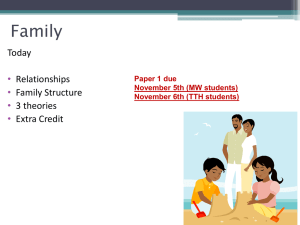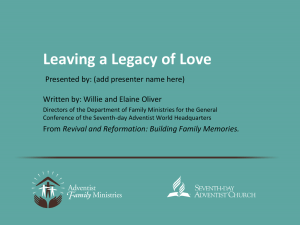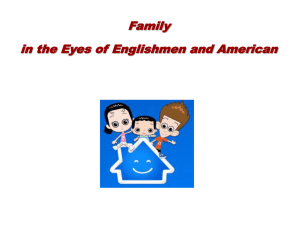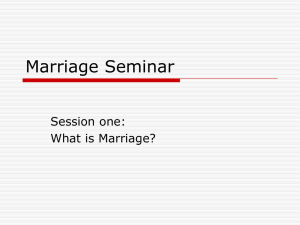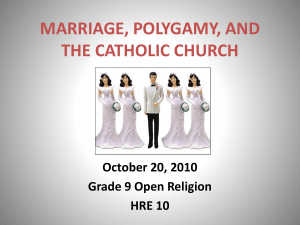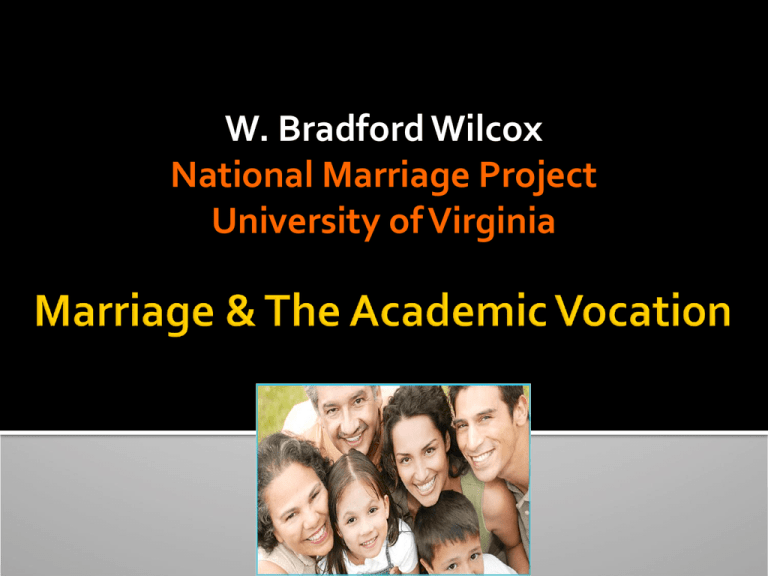
W. Bradford Wilcox
National Marriage Project
University of Virginia
Where are we headed?
1. The Retreat from Marriage in America
2. The Impact on Education
3. The Impact on the Catholic Church
4. What Can Universities Do?
2
Since the 1960s, the U.S. has witnessed a
marked retreat from marriage. The
institution of marriage has lost authority,
power, and social functions.
Marriage is less likely to anchor the adult life
course
Marriage is less likely to frame adult sexual
and/or coresidential romantic relationships
Marriage is less likely to provide a stable context
for the bearing and rearing of children
3
Percentage of Persons Age 35 through 44 Who Were Married, by Sex, 1960–
2008, U.S. Census Bureau
100
95
Percent
90 88
89
84
85
Men
Women
80
74
75
70
65
1960
69
1970
1980
1990
2000
66
2009
Year
4
5
Percent of married adults reporting “very happy”
75
70
70
68
66
Men
65
65
66
63
63
63
64
62
60
55
1973–1976
1977–1981
1982–1986
60
60
1987–1991
1993–1996
61
1998–2002
Women
60
2004–2008
6
Number of Unmarried Cohabiting Adult Opposite-Sex
Couples, by Year, United States
Number in Millions
8
7.5
7
6
5
4
3.8
2.9
3
2
1.6
1
0
0.4
1960
0.5
1970
1980
1990
2000
2010
Year
7
Percentage of Live Births to Unmarried Women, by Year,
United Statesa
Percentage of Live Births to Unmarried Women, by Year, United Statesa
80
70
Percent
Percent
60
50
40
80
70
60
50
40
30
20 5
10
0
1960
28
10
18
11
Blacks
41
1970
1980
1990
28
2000
33
All
2008
Year
18
5
All
Whites
30
20
41
33
Blacks
11
Whites
0
1960
1970
1980
1990
2000
2008
Year
8
Percentage of Children Under Age 18 Living with Two Married Parents
by Year and Race, Source: NMP 2010
90
88
Percentage
80
85
77
70
73
69
67
60
50
All
Blacks
Whites
40
30
1960
1970
1980
1990
2000
2009
Year
9
The retreat from marriage has hit working
class and poor Americans especially hard.
College-educated Americans have been
much less affected by this retreat.
10
90%
80% 81%
80%
70%
74%
65%
58%
60%
1974–81
52%
2000–07
50%
40%
30%
Least-educated
Mother
Moderately
Educated Mother
Highly Educated
Mother
11
The nation’s (stratified) retreat from marriage
means that children who are fortunate
enough to come from an intact, married
family are more likely to
Graduate from high school & college.
Young adults who live chastely are more
likely to flourish in college:
▪ Chaste women have fewer emotional problems;
▪ Chaste men do better academically.
% Teens dropping out of high school
20
15
US
10
5
0
Intact
Single
Family Status
Source: McLanahan
and Sandefur 1994
13
Percent of Young Adults Graduating from
College (Add Health 2008)
40
38
35
30
25
20
20
15
10
5
0
Intact
Non-intact
Thus, children who hail from intact, married
homes are more likely to succeed in their
academic vocations.
Unfortunately, given the fact that marriage is
now strongest among the most educated and
affluent Americans, this means that children
from these homes are often doubly
advantaged by
their parents’ marriage & socioeconomic resources.
Mix of Hanging Out, Hooking Up, Joined at
the Hip, Semi-traditional Dating
No single set of courtship norms and
common courtship practices to guide
relationships.
40-64% of college students report hooking up
(Regnerus 2011).
Psychological effects are more profound for
women
One study: In previous year for those who hooked
up:
▪ Women:
▪ 49% reported a negative reaction
▪ 25% reported an ambivalent reaction
▪ 26% reported a positive reaction
▪ Men:
▪
▪
▪
▪
26% reported a negative reaction
24% reported an ambivalent reaction
50% reported a positive reaction
Source: (Owen et al 2009)
20
20
20
18
15
16
14
12
12
10
10
8
Men
7
8
6
6
4
2
0
Zero
One
Two-Five
Women
Six+
Players get distracted
Economist Joseph Sabia (2007) finds that
sexually active young men do significantly
poorer in their academic work
▪ The pleasures of sex “may induce boys to choose
immediate investments in sex over schooling.”
▪ Status & pleasure > school
The fortunes of the Catholic Church in the U.S. rise
& fall with the fortunes of the intact, married family
Intact married families
▪ Successfully socialize children into the faith &
▪ Orient adults to the moral, social, & spiritual goods found
in the faith
20
Parenthood draws adults into
the Church
1) Parenthood is a generative experience
2) Churches supply religious and moral education
to children
3) Churches offer parent-centered social networks
where parents receive social support & counsel
21
Marriage fosters higher religious practice
1) The Church lends social, religious, and moral
support to marriage
2) Marriage associated with prosocial norms
3) Churches supply marriage-centered networks to
couples
22
Percent More/Less Likely to Attend
than Unmarried, No Kids
Family Demography and Weekly Religious
Attendance among U.S. Adults (18-60)
70%
62%
60%
50%
40%
30%
20%
14%
10%
0%
Married with Kids
-10% Unmarried with Kids Married, No Kids
-20%
-30%
-23% Source: General Social Survey (1972-2008)
Note: Analysis controls for income, education, race,
ethnicity, region, sex, age, and year.
23
Percent Attending 2 Times a Month or More
(Source: GSS)
50
45
44
40
39
35
30
25
20
1970s
2000s
24
How can Catholic colleges & universities
strengthen marriage?
Require classes that provide a theological & social
scientific view of marriage
Act In Loco Parentis
25
Most colleges & universities are doing poorly in
preparing the next generation for one of the most
important sources of meaning and purpose in life—
the vocation of marriage.
For instance, most students are ignorant of the fact
that premarital sex is a risk factor for divorce (Paik
2011).
Catholic colleges can remedy this
ignorance with theological &
sociological classes.
26
Given the academic, marital, & religious
importance of renewing the collegiate
relationship culture, Catholic colleges and
universities should
Support single-sex dorms
Rely on parietals to govern visitation
Support student groups seeking to educate their
peers about sex & marriage
Make the sacraments readily available to students.

